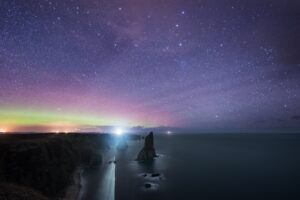The Aurora Borealis, known as the Northern Lights, is one of nature's most mesmerising spectacles. While many associate it with Arctic destinations like Norway or Iceland, you can witness this incredible light show from parts of Scotland.
With the right conditions, the night skies above Scotland can dance with vibrant green, purple, and red hues, making this a truly unforgettable experience.
Yes, you can! Scotland is one of the best places in the UK to see the Northern Lights, thanks to its northern latitude and remote, low-light environments. The lights are referred to as "Mirrie Dancers" in Shetland. A charming old Scots name that reflects the awe they inspire.
While sightings aren't guaranteed, the further North you go, the clearer and darker the skies, and the better your chances. On nights of strong solar activity, the aurora can even be visible from parts of central or southern Scotland, though this is rare.
Scotland's northern and coastal locations offer the best chances of spotting the aurora. These areas combine northern latitude, low light pollution, and big, open skies.
Even in the Outer Hebrides, such as Harris and Lewis, have witnessed spectacular auroral shows.
The aurora borealis season in Scotland typically runs from September to March, when the nights are long and dark. The best time to see them is between 9 pm and 1 am, though displays can happen anytime during the night.
Key factors to improve your chances include:
Auroras tend to follow periods of solar storms, bursts of energy from the sun that interact with Earth's magnetic field. Keeping an eye on forecasts is essential.
Scotland's more remote areas are accessible by a mix of road, ferry, and air travel:
Seeing the Aurora Borealis in Scotland is never guaranteed, but that's part of what makes it so magical. On the right night, with the right weather, you could find yourself standing beneath shimmering ribbons of light that turn the sky into a living painting. Whether you're in the far North or lucky enough to catch a rare Southern display, it's a memory that will stay with you for life.

The Northern Lights (Aurora Borealis) can be seen in Scotland, especially from the North and in areas with low light pollution like Shetland, Orkney, and the Highlands.
The best time is between September and March when the nights are the longest. Clear skies and high solar activity are essential for a good display.
The Northern Lights, caused by solar particles colliding with Earth's atmosphere, creating glowing light patterns, usually near the magnetic poles.
You don't need special equipment to see them, but a camera can help you relive the moment.
"Aurora Borealis" is the scientific name, meaning "northern dawn" in Latin. "Northern Lights" is the more commonly used name in English, especially in everyday conversation. Both terms describe the same natural light display.